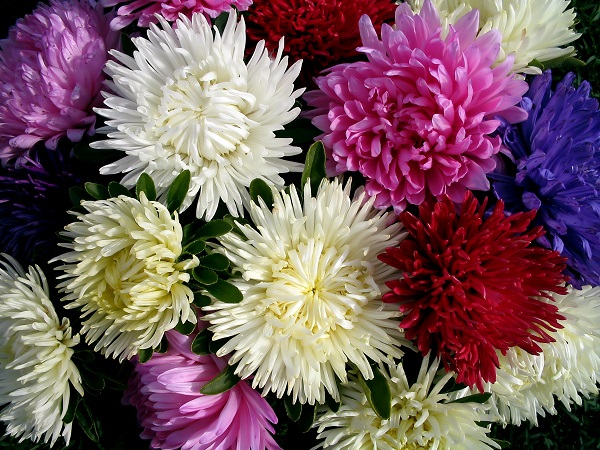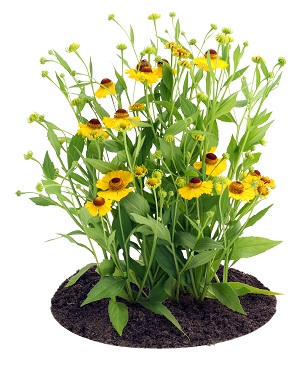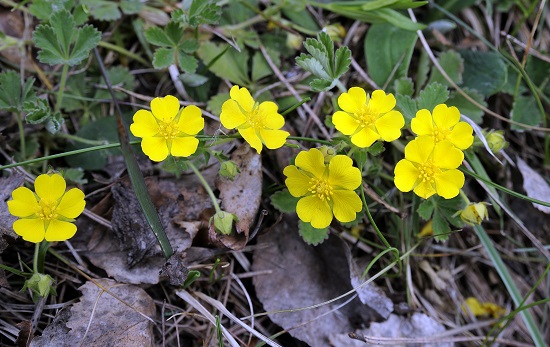How do you know if you have clay-based soil? Clay-based soil drains water out very slowly and due to this, growing most plants is difficult. Clay-based soil can be anywhere but as a rule southern states tend to have more clay in the soils then any other region in the USA.
One very simple way to get around clay-based soil is to use a raised garden bed and fill it in with non-clay-based soil. If this is not an option these ten plants will do well in clay-based soil.

Aster
A great cut flower, asters make any garden burst with color at the end of the growing season. From miniature alpine plants to giants up to 6 feet tall, there are over 250 asters, with plenty of colors to choose from. Asters are a great way to brighten up the fall landscape in your backyard.
- Common Names: Aster, Michaelmas daisy.
- Botanical Name: Aster.
- Bloom Time: Late summer through fall.
- Size: 3 to 6 feet high (dwarf varieties are shorter).
- Flowers: Purple, white, pink, blue, and red daisy-like flowers.
- Light Needs: Full sun to partial shade.
Black-eyed Susan
If hardy and fuss-free describe your ideal flower, then black-eyed Susans are a must in your garden. These golden beauties come in a wide range of blooms so no matter what flowers you already have growing in your garden, black-eyed Susans are sure to be a great addition.
- Common Names: Black-eyed Susan, gloriosa daisy.
- Botanical Name: Rudbeckia.
- Bloom Time: Summer through fall.
- Size: 1 to 6 feet high.
- Flowers: Yellow, orange, and russet petals with black-brown or green centers.
- Light Needs: Full sun; will tolerate light shade.
Coreopsis

With its demure veil of jeweled blooms, coreopsis adds charm to cottage gardens and formal flower beds alike. Dainty flowers, thin stems and fine foliage disguise the fact that this plant’s as tough as nails. It’s also great for cutting and readily attracts butterflies.
- Common Names: Coreopsis, tickseed, butter daisy.
- Botanical Name: Coreopsis.
- Bloom Time: Late spring through late summer.
- Size: 8 to 48 inches high, 8 to 36 inches wide.
- Flowers: Yellow, orange, maroon, red and pink; daisy-like single, semi-double, or double blooms 1/2 to 3 inches wide. Petals are often notched.
- Light needs: Full sun.
Daylily
This garden favorite is cherished for its beauty, reliability, and variety. With more than 50,000 named cultivars, gardeners have almost limitless choices. Blossoms last just a day, but many hybrids flower repeatedly.
- Common Names: Daylily.
- Botanical Name: Hemerocallis.
- Bloom Time: Early summer until first frost.
- Size: 10 inches to 4 feet high, 1-1/2 to 4 feet wide.
- Flowers: Every shade except blue and pure white.
- Light Needs: Full sun to partial shade.
Ferns
These plants are so popular that they have an entire society named after them. The American Fern Society is more than 100 years old and is made up of people who celebrate the 12,000+ species available today. Ferns are so versatile. You can find a plant for just about any growing condition…sun, shade, indoors or outdoors. They even grow great in clay!
- Common Names: Fern.
- Botanical Name: Various, including Ostrich fern (Matteuccia) and Cinnamon fern (Osmunda).
- Bloom Time: N/A; grown for foliage.
- Size: 4 to 48 inches high, 8 to 36 inches wide.
- Foliage: Various shades of green.
Japanese Iris
When Japanese iris begins blooming in late spring, it’s difficult not to stop and admire its beauty. Irises are among the most showy and easiest to recognize of all garden flowers – and Japanese irises are no exception. It’s also one of the most common beardless irises, which are generally easier to grow and more adaptable than bearded types. Choose Japanese irises for a beautiful way to welcome the summer growing season.
- Common Names: Japanese iris.
- Botanical Name: Iris ensata.
- Bloom Time: Late spring to early summer.
- Size: 3 to 4 feet high.
- Flowers: Shades of purple, wine-red, and white. Large, flat form.
Runner Bean
The runner bean is grown for its showy pea-shaped flowers. It is a twining climber, which may need to be trained up a trellis or arbor with netting or string. This vine is fast-growing and will attract butterflies and hummingbirds to your backyard garden.
- Common Names: Runner bean, Scarlet runner bean.
- Botanical Name: Phaseolus coccineus.
- Bloom Time: Spring to summer.
- Size: Up to 8 feet high.
- Flower: Bright red.
- Light Needs: Full sun, but can tolerate some shade.
Switchgrass
This native grass is a fitting selection for wet conditions, drought, or partial shade. It grows narrowly upright, reaching 3 feet tall with drooping spikes. Purple flowers are borne in early fall that fade to golden, providing a bright color interest on bleak winter days.
- Common Names: Switchgrass.
- Botanical Name: Panicum virgatum.
- Bloom Time: Early autumn.
- Size: 3 to 7 feet high, 2 to 3 feet wide.
- Flower/foliage: Purple-green flowers; mid-green or metallic-blue leaves that turn yellow or reddish-purple in autumn.
- Light Needs: Full sun, though tolerant of partial shade.

Potentilla
By the time many other flowering shrubs’ colorful show is all but a memory, potentilla is just beginning its long flowering season. It’s a sure winner because its blooms will last until the first hard frost. Tolerant of heat, drought, clay, and sandy soils, potentillas create a lasting impression.
- Common Names: Potentilla, bush cinquefoil.
- Botanical Name: Potentilla fruitcosa.
- Bloom Time: Late spring to first frost.
- Size: 1 to 4 feet high, 2 to 4 feet wide.
- Flowers: Yellow, white, orange, and red.
Viburnum
Among the most popular of ornamental shrubs and small trees, the viburnum is sought after for three reasons – it’s beautiful, it’s versatile, and it’s easy to grow. What’s more, there are three prime features that contribute to the year-long beauty of the viburnum – the flowers, the leaves and the colorful fruits it produces. If you don’t already grow this showpiece, now’s the time to start – it’ll triple your pleasure outdoors.
- Common Name: Virburnum.
- Botanical Name: Viburnum.
- Bloom Time: Late spring to early summer.
- Size: 4 to 30 feet high.
- Foliage: Varies from shiny to leathery textures of green – turning yellowish-orange or reddish purple in fall.
- Light needs: Full sun to partial shade.
Samantha Michaels in an avid gardener and freelance author.
Related Articles & Free Email Newsletter Sign Up
10 Great Plants for a Perennial Flower Garden for Spring
How to Design an All-Season Perennial Flower Garden for Fall
How to Design the Perfect Perennial Flower Garden for Summer




Comment here